Themed collection Ion Mobility Mass Spectrometry

Ion Mobility Mass Spectrometry
Welcome to this Analyst themed issue on ion mobility mass spectrometry, guest edited by Perdita Barran and Brandon Ruotolo.

Analyst, 2015,140, 6772-6774
https://doi.org/10.1039/C5AN90076J
The application of FAIMS gas analysis in medical diagnostics
There is an ever increasing need to develop new tools to aid in the diagnosis and monitoring of human diseases.
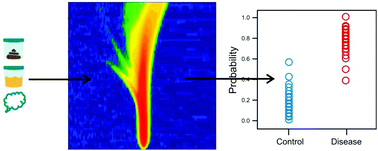
Analyst, 2015,140, 6775-6781
https://doi.org/10.1039/C5AN00868A
Advances in ion mobility-mass spectrometry instrumentation and techniques for characterizing structural heterogeneity
Enabling IM-MS instrumentation and techniques for characterizing sample structural heterogeneity have developed rapidly over the last five years.
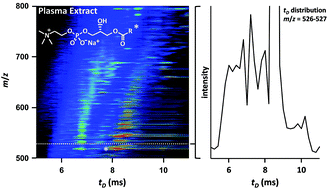
Analyst, 2015,140, 6782-6798
https://doi.org/10.1039/C5AN00922G
Multiple gas-phase conformations of proline-containing peptides: is it always cis/trans isomerization?
Ion mobility-mass spectrometry (IM-MS) is often employed to look at the secondary, tertiary, and quaternary structures of naked peptides and proteins in the gas-phase.

Analyst, 2016,141, 4863-4869
https://doi.org/10.1039/C5AN00835B
EM∩IM: software for relating ion mobility mass spectrometry and electron microscopy data
EM∩IM enables the calculation of collision cross-sections from electron density maps obtained, for example, by means of transmission electron microscopy. This capability will further aid the integration of ion mobility mass spectrometry with modern structural biology.
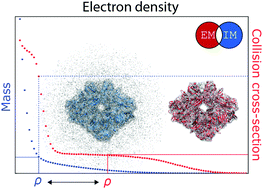
Analyst, 2016,141, 70-75
https://doi.org/10.1039/C5AN01636C
Collision cross sections of high-mannose N-glycans in commonly observed adduct states – identification of gas-phase conformers unique to [M − H]− ions
We report collision cross sections (CCS) of high-mannose N-glycans as [M + Na]+, [M + K]+, [M + H]+, [M + Cl]−, [M + H2PO4]− and [M − H]− ions, measured by drift tube (DT) ion mobility-mass spectrometry (IM-MS) in helium and nitrogen gases.
![Graphical abstract: Collision cross sections of high-mannose N-glycans in commonly observed adduct states – identification of gas-phase conformers unique to [M − H]− ions](/en/Image/Get?imageInfo.ImageType=GA&imageInfo.ImageIdentifier.ManuscriptID=C5AN01092F&imageInfo.ImageIdentifier.Year=2015)
Analyst, 2015,140, 6799-6803
https://doi.org/10.1039/C5AN01092F
Combining density functional theory (DFT) and collision cross-section (CCS) calculations to analyze the gas-phase behaviour of small molecules and their protonation site isomers
Computational methods are employed to study the protomers in ESI-IM-MS.
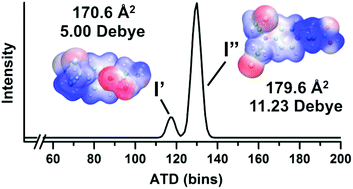
Analyst, 2016,141, 4044-4054
https://doi.org/10.1039/C5AN02456K
Top-down mass spectrometry of hybrid materials with hydrophobic peptide and hydrophilic or hydrophobic polymer blocks
Top-down, multidimensional mass spectrometry for the molecular level characterization of polymer–peptide or polymer–protein conjugates that cannot be crystallized or chromatographically purified.
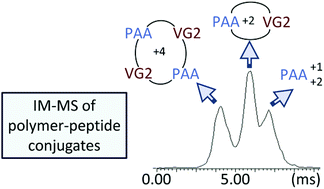
Analyst, 2015,140, 7550-7564
https://doi.org/10.1039/C5AN01600B
Ion mobility coupled to native mass spectrometry as a relevant tool to investigate extremely small ligand-induced conformational changes
Native and ion-mobility mass spectrometry reveal the conformational evolution over time of a peptide deformylase binding different ligands, which is consistent with slow-tight inhibition of the enzyme.
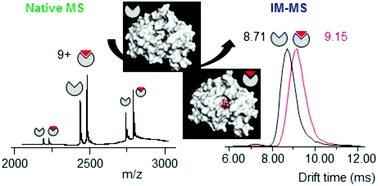
Analyst, 2015,140, 7234-7245
https://doi.org/10.1039/C5AN01311A
Early stages of insulin fibrillogenesis examined with ion mobility mass spectrometry and molecular modelling
Mass spectrometry shows insulin oligomers [I]n where n ranges from 1-12, and ion mobility analysis reveals ∼60 structurally distinct species across this oligomer distribution. Experimental data trains MD simulations to characterize a persistent prefibrillar protein oligomer that is a dimer enriched in β sheets.
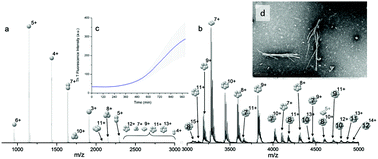
Analyst, 2015,140, 7000-7011
https://doi.org/10.1039/C5AN01253H
Illustration of SID-IM-SID (surface-induced dissociation-ion mobility-SID) mass spectrometry: homo and hetero model protein complexes
Surface collisions generate subcomplexes, which are then separated by ion mobility and dissociated into their individual subunits via a second stage of surface collisions to elucidate protein complex architecture and assembly.
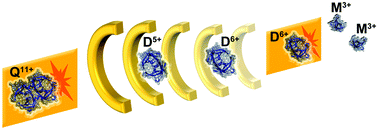
Analyst, 2015,140, 7012-7019
https://doi.org/10.1039/C5AN01095K
Resolving powers of >7900 using linked scans: how well does resolving power describe the separation capability of differential ion mobility spectrometry
Linked scans of the differential ion mobility spectrometry carrier gas and compensation field yield resolving powers >7900, more than 16 times greater than the best previously reported values.
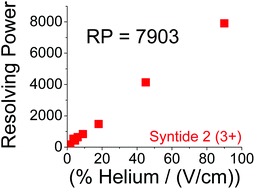
Analyst, 2015,140, 6871-6878
https://doi.org/10.1039/C5AN00845J
Ion mobility-mass spectrometry of charge-reduced protein complexes reveals general trends in the collisional ejection of compact subunits
Multiprotein complexes have been shown to play critical roles across a wide range of cellular functions, but most probes of protein quaternary structure are limited in their ability to analyze complex mixtures and polydisperse structures using small amounts of total protein.
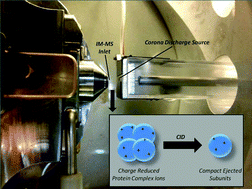
Analyst, 2015,140, 7020-7029
https://doi.org/10.1039/C5AN01242B
High resolution ion mobility-mass spectrometry for separation and identification of isomeric lipids
Separation and identification of isomeric species is a major challenge in lipidomics. Herein, we demonstrate that lipid isomers that differ only in position of the acyl chain, position of the double bond or double bond geometry can be distinguished using drift-tube ion mobility-mass spectrometry, even in complex biological samples.
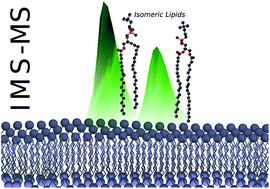
Analyst, 2015,140, 6904-6911
https://doi.org/10.1039/C5AN00838G
Ion manipulations in structures for lossless ion manipulations (SLIM): computational evaluation of a 90° turn and a switch
Mobility Selected Ion Manipulations into Orthogonal Channels.
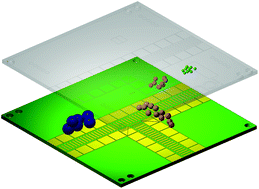
Analyst, 2015,140, 6845-6852
https://doi.org/10.1039/C5AN00844A
Investigating carbohydrate isomers by IMS-CID-IMS-MS: precursor and fragment ion cross-sections
Fragmentation of melezitose by IMS-CID-IMS-MS.
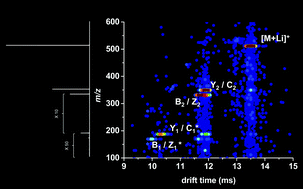
Analyst, 2015,140, 6922-6932
https://doi.org/10.1039/C5AN00840A
A two-phase approach to fourier transform ion mobility time-of-flight mass spectrometry
A new two-phased approach to combining raw frequency encoded data enables enhanced levels of signal to noise ratio for ion mobility mass spectrometry experiments.
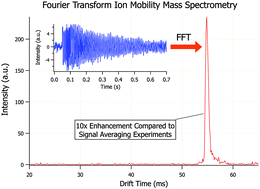
Analyst, 2015,140, 6862-6870
https://doi.org/10.1039/C5AN00941C
Ion-neutral collisional cross sections of carbohydrate isomers as divalent cation adducts and their electron transfer products
This paper reports on the use of divalent metal ion adduction, gas-phase electron transfer reactions, and ion mobility spectrometry to discriminate among isomeric oligosaccharides.
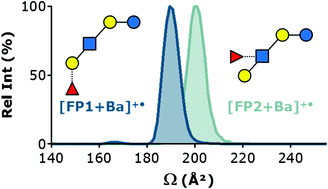
Analyst, 2015,140, 6912-6921
https://doi.org/10.1039/C5AN01093D
Collision-energy resolved ion mobility characterization of isomeric mixtures
Existing instrumental resolving power limitations in ion mobility spectrometry (IMS) often restrict adequate characterization of unresolved or co-eluting chemical isomers.
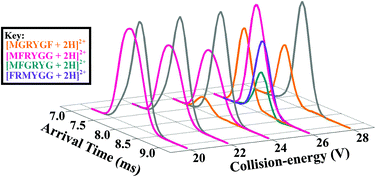
Analyst, 2015,140, 6886-6896
https://doi.org/10.1039/C5AN00940E
Liquid extraction surface analysis field asymmetric waveform ion mobility spectrometry mass spectrometry for the analysis of dried blood spots
LESA mass spectrometry coupled with high field asymmetric waveform ion mobility spectrometry (FAIMS) for the analysis of dried blood spots.
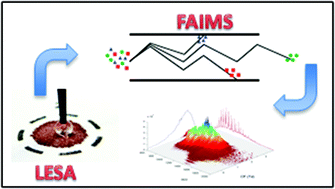
Analyst, 2015,140, 6879-6885
https://doi.org/10.1039/C5AN00933B
Insights into the consequences of co-polymerisation in the early stages of IAPP and Aβ peptide assembly from mass spectrometry
The precise molecular mechanisms by which different peptides and proteins assemble into highly ordered amyloid deposits remain elusive.

Analyst, 2015,140, 6990-6999
https://doi.org/10.1039/C5AN00865D
Evaluation of drift gas selection in complex sample analyses using a high performance drift tube ion mobility-QTOF mass spectrometer
Drift gas selection in an ion mobility-QTOF can affect the separation of targeted isomeric compounds and collision cross section values.
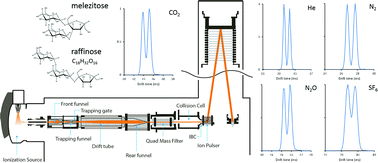
Analyst, 2015,140, 6834-6844
https://doi.org/10.1039/C5AN00991J
Broadscale resolving power performance of a high precision uniform field ion mobility-mass spectrometer
3D surface mapping of the IM-MS instrument performance allows the maximum resolving power to be accessed for any ion system.
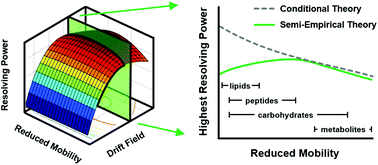
Analyst, 2015,140, 6824-6833
https://doi.org/10.1039/C5AN00923E
A local collision probability approximation for predicting momentum transfer cross sections
The local collision probability approximation (LCPA) method is introduced to compute molecular momentum transfer cross sections for comparison to ion mobility experiments.
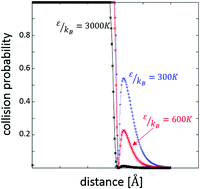
Analyst, 2015,140, 6804-6813
https://doi.org/10.1039/C5AN00712G
Using differential mobility spectrometry to measure ion solvation: an examination of the roles of solvents and ionic structures in separating quinoline-based drugs
Understanding the mechanisms and energetics of ion solvation using differential mobility spectrometry.
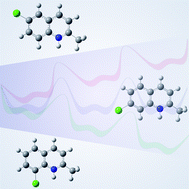
Analyst, 2015,140, 6897-6903
https://doi.org/10.1039/C5AN00842E
Collision cross section calibrants for negative ion mode traveling wave ion mobility-mass spectrometry
Introduction of a novel negative mode calibrant and evaluation of calibration strategies for TWIM CCS determination.
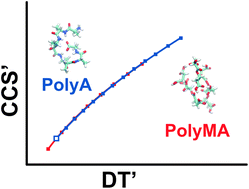
Analyst, 2015,140, 6853-6861
https://doi.org/10.1039/C5AN00946D
Enhancing biological analyses with three dimensional field asymmetric ion mobility, low field drift tube ion mobility and mass spectrometry (μFAIMS/IMS-MS) separations
Novel μFAIMS/IMS-MS three dimensional separations were optimized to enhance separation power and selectivity in biological analyses.
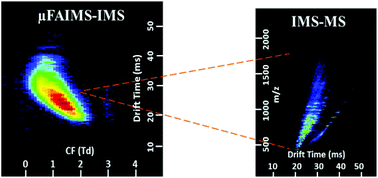
Analyst, 2015,140, 6955-6963
https://doi.org/10.1039/C5AN00897B
How useful is molecular modelling in combination with ion mobility mass spectrometry for ‘small molecule’ ion mobility collision cross-sections?
Evaluation of N2(g) and He(g) MOBCAL collision cross section values from 20 compounds ∼ m/z 122 to 609.
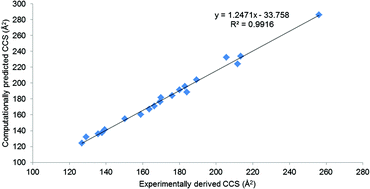
Analyst, 2015,140, 6814-6823
https://doi.org/10.1039/C5AN00411J
Comparing equilibrium and kinetic protein unfolding using time-resolved electrospray-coupled ion mobility mass spectrometry
We apply a new hyphenated method, TRESI-IMS-MS, to compare equilibrium and kinetic unfolding intermediates of cytochrome c.
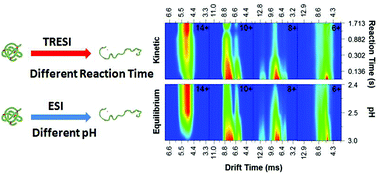
Analyst, 2015,140, 6973-6979
https://doi.org/10.1039/C5AN00843C
Investigating changes in the gas-phase conformation of Antithrombin III upon binding of Arixtra using traveling wave ion mobility spectrometry (TWIMS)
We validate the utility of ion mobility to measure protein conformational changes induced by the binding of glycosaminoglycan ligands.
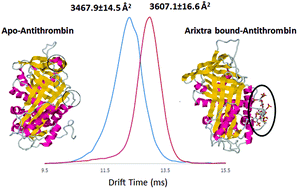
Analyst, 2015,140, 6980-6989
https://doi.org/10.1039/C5AN00908A
Microheterogeneity within conformational states of ubiquitin revealed by high resolution trapped ion mobility spectrometry
The present work employs trapped ion mobility spectrometry (TIMS) for the analysis of ubiquitin ions known to display a multitude of previously unresolved interchangeable conformations upon electrospray ionization.
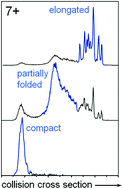
Analyst, 2015,140, 6964-6972
https://doi.org/10.1039/C5AN00841G
Effects of charge states, charge sites and side chain interactions on conformational preferences of a series of model peptide ions
The factors affecting conformational preference of gas phase peptide ions are investigated by IM-MS and molecular dynamics simulation.
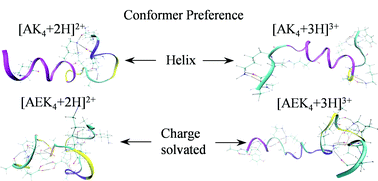
Analyst, 2015,140, 6933-6944
https://doi.org/10.1039/C5AN00826C
Modeling vapor uptake induced mobility shifts in peptide ions observed with transversal modulation ion mobility spectrometry-mass spectrometry
Adsorption models are used to explain vapor dopant facilitated mobility shifts for peptide ions.
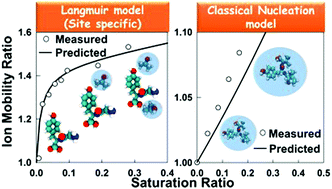
Analyst, 2015,140, 6945-6954
https://doi.org/10.1039/C5AN00753D
About this collection
Guest Edited by Professor Perdita Barran and Professor Brandon Ruotolo this themed collection showcases the latest technology, method and application-based science working in both academia and industry. Highlighting key advances in ion mobility-mass spectrometry-themed science in the areas of: chemical threat detection, new instrumentation, gas-phase ion mobility analysis/ theory, biomolecular structure, complex mixture analysis, proteomics, bioinformatics, supramolecular chemistry, polymer analysis, new ionization sources, and drug discovery/development.